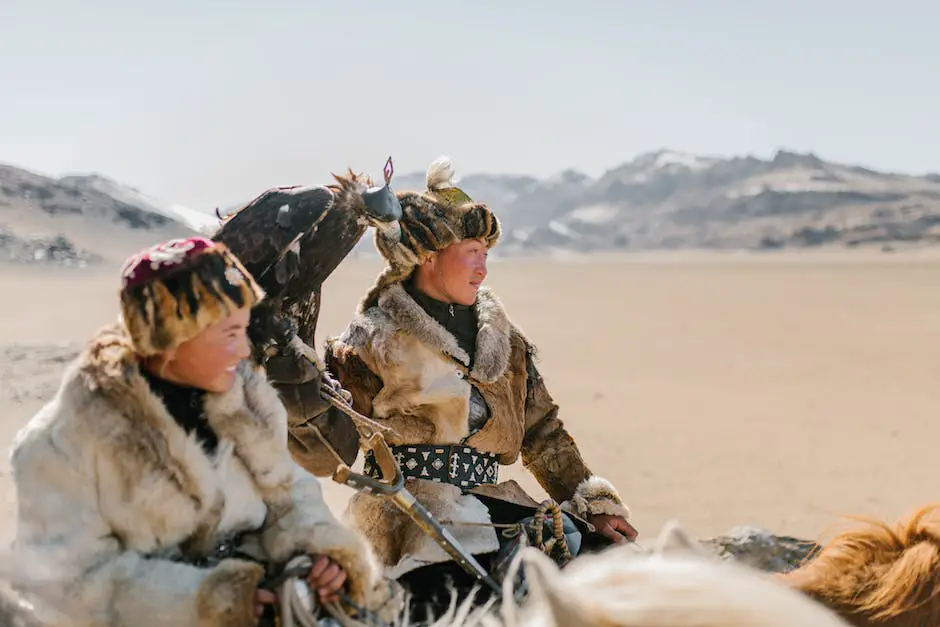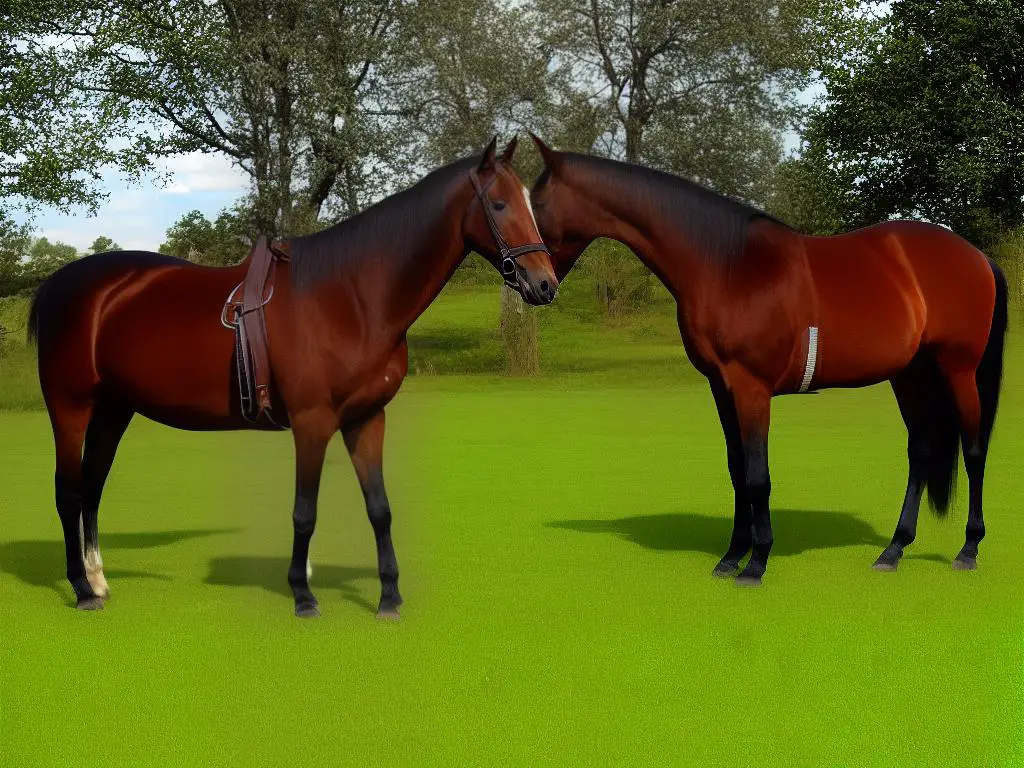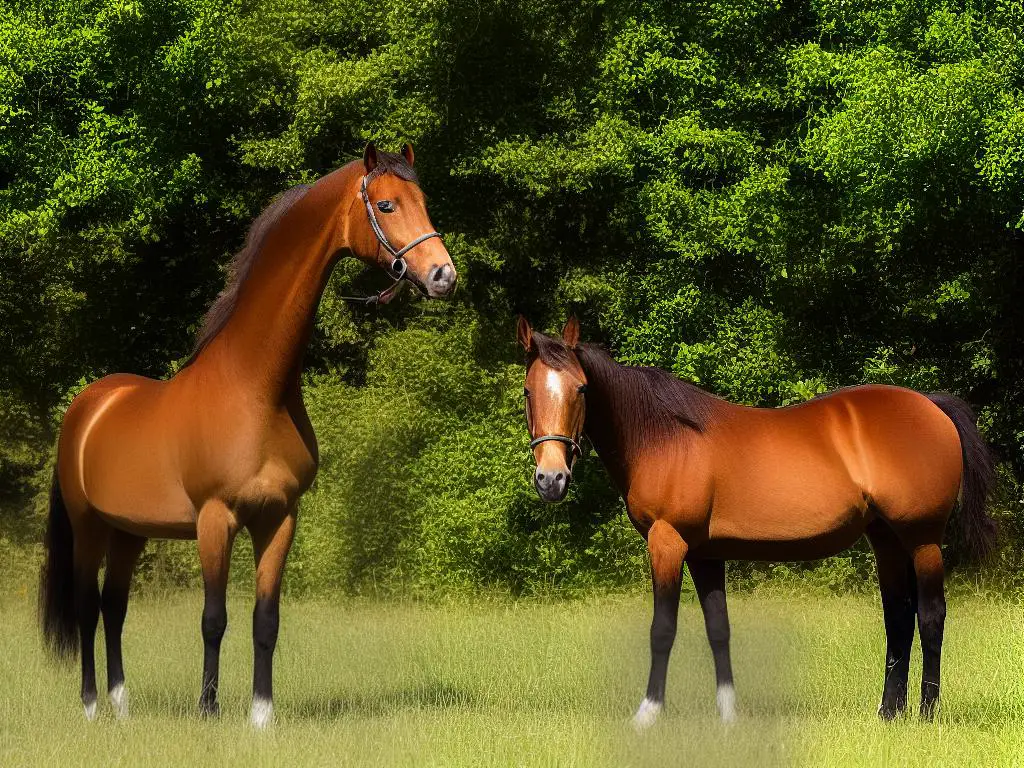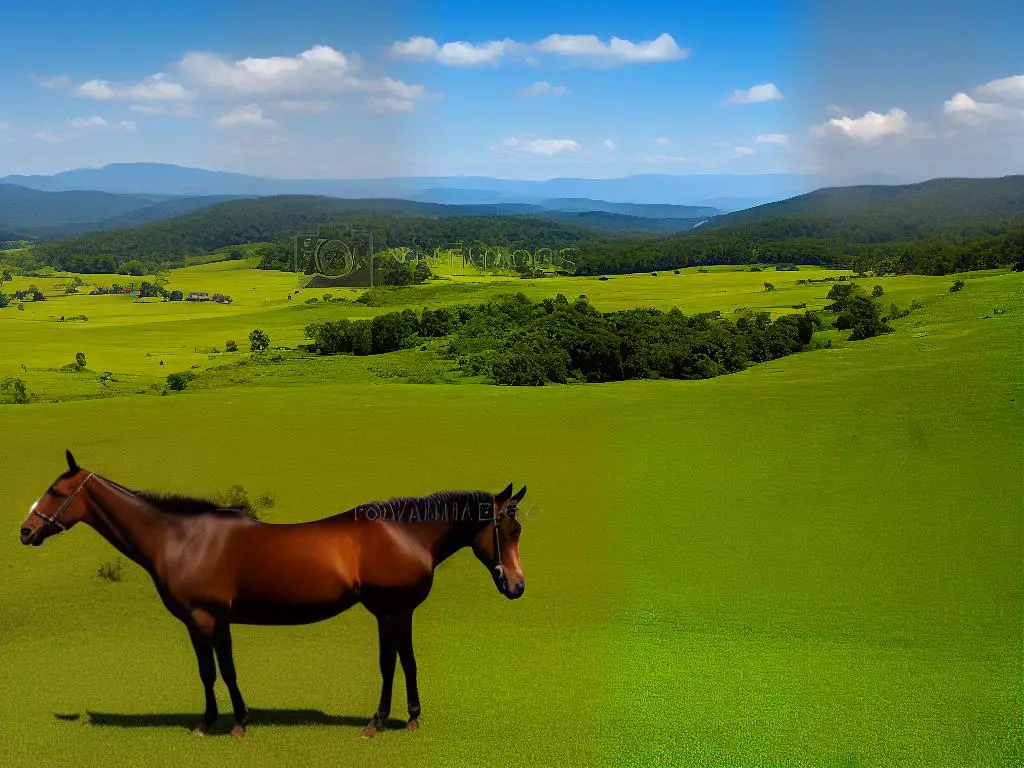The Kentucky Saddler is a majestic horse breed steeped in history and admired by enthusiasts for its unique characteristics and unparalleled grace. With roots in the early American South, the Kentucky Saddler has earned a reputation for its exceptional gait and ability to cover long distances with ease. In this article, we will delve into the rich history, distinctive traits, and thriving legacy of this cherished breed.
Table of Contents (Horspedia)
History of the Kentucky Saddler
History of the Kentucky Saddler Breed
Originating in the American South, the Kentucky Saddler was developed in the late 18th century to be a sturdy and versatile horse, capable of performing a wide range of tasks. The breed’s unique characteristics, such as its distinct four-beat lateral ambling gait, made it highly sought-after by enthusiasts and horsemen.
The Kentucky Saddler’s Smooth and Comfortable Gait
A key factor in the development of the Kentucky Saddler was the evolution of its smooth, comfortable gait. This characteristic made the breed an ideal choice for those seeking versatile equestrian companions, particularly early American settlers who needed dependable horses to cover vast expanses of the developing nation.
The Kentucky Saddler’s Calm and Willing Temperament
In addition to its unique gait, the Kentucky Saddler’s lineage gave it a reputation for having a gentle and willing temperament. Over the years, the breed has been favored by many famous figures in American history, and its versatility and reliability have made it an invaluable resource in early America.
The Kentucky Saddler’s Popularity and Status Today
Throughout the 19th and 20th centuries, the Kentucky Saddler continued to grow in popularity. Today, the breed remains a staple of American equestrian culture, often participating in saddle seat competitions and other equestrian events. The creation of the Kentucky Saddler Horse Association further cemented the breed’s status, promoting the preservation and celebration of its lineage.
The Endurance and Athleticism of the Kentucky Saddler
Renowned for its endurance and athleticism, the Kentucky Saddler has become a popular choice for modern-day long-distance trail riding, reflecting its storied American heritage.

Breed Characteristics and Traits
Known as the American Saddlebred or simply “Saddlebred”, the Kentucky Saddler is a versatile and elegant breed with a rich history. Its athletic capabilities, distinctive high-stepping gait, and impressive physical traits harmoniously combine to create a majestic appearance. As a result, horse enthusiasts and hobbyists highly seek after this breed for its performance abilities, beauty, and grace.
One of the striking features of the Kentucky Saddler lineage is its unique conformation. Standing at 15 to 16 hands tall, the Saddlebred possesses an elegant arched neck, which is accentuated by a long, sloping shoulder supporting a finely chiseled and expressive head. The body is streamlined with a broad chest and well-sprung ribs, while the back is relatively short and strong, giving the horse a balanced and powerful appearance. The hindquarters are muscular and sloping, which lends well to the breed’s exceptional athleticism and propulsion during their signature high-stepping gaits.
The gait of the Kentucky Saddler is another alluring characteristic that sets it apart from other horse breeds. While they are naturally gifted with the traditional walk, trot, and canter, Saddlebreds are also capable of performing two additional gaits – the slow gait and the rack. Both of these gaits are considered high and distinct four-beat motions, making the horses appear as if they are floating on air. The slow gait is a collection of the ordinary walk, while the rack is a quick and highly animated gait that showcases the breed’s exceptional strength, flexibility, and coordination.
Another important trait to consider when examining the Kentucky Saddler lineage is their temperament. These horses are known for their intelligent and willing nature, which makes them easy to train and adaptable to various disciplines. Saddlebreds have been successful in a wide range of equestrian pursuits, including saddle-seat, driving, dressage, show jumping, and even western pleasure and trail riding. Their desire to please and natural curiosity make them an excellent choice for both experienced and novice horse owners and riders.
As an enthusiast or hobbyist looking to become skilled in Kentucky Saddler lineage, it is important to recognize their versatile capabilities, unique characteristics, and diverse range of coat colors. This breed, also known as the American Saddlebred, can be found in a variety of colors, including solid black, bay, and chestnut, as well as eye-catching and rare colors such as pinto patterns, palomino, and even silver dapple.

Photo by danielbonillao on Unsplash
Famous Bloodlines and Notable Horses
With their distinct high-stepping gaits and elegant appearance, the Kentucky Saddler captivates observers and makes them popular among enthusiasts and hobbyists alike. This breed boasts exceptional bloodlines and has a rich history to explore. As you continue your journey into the world of Kentucky Saddlers, you’ll discover the intricacies of their lineage and understand the significance of preserving and celebrating their legacy.
Several American Saddlebred bloodlines emerge as foundation lines in the breed, and have played a significant role in shaping its characteristics and legacy.One of the most famous sires in the breed’s lineage is Denmark F.S., known as the “father” of the Kentucky Saddler.Another prominent Saddlebred bloodline originating from Denmark F.S. is that of Rex McDonald, foaled in 1890.One of the most famous dams within the Kentucky Saddler bloodline is Edna May, a grey mare born in 1898.The influence of Wing Commander, a stunning chestnut stallion, can also be seen throughout the lineage of the Kentucky Saddler.The Kentucky Saddler lineage boasts a rich history, with influential sires playing a significant role in shaping the breed. One such sire is Supreme Sultan, foaled in 1966, who left an indelible mark on the breed’s development and contributed immensely to the characteristics we associate with the Kentucky Saddler today.

Breeding Practices and Preservation
As enthusiasts and hobbyists looking to become skilled in the Kentucky Saddler lineage, it’s crucial to promote responsible breeding practices to preserve this remarkable breed. This includes selecting only the healthiest and best-suited horses for breeding while avoiding inbreeding and overbreeding. Adherence to these guidelines ensures the maintenance of the breed’s genetic diversity, ultimately improving its overall health. By doing so, the unique characteristics of the Kentucky Saddler will remain a cherished part of equine history for generations to come.
In addition to responsible breeding practices, numerous resources are available for breeders to enhance their knowledge and skills in maintaining the Kentucky Saddler lineage. Attending educational workshops, seminars, and conferences can provide breeders with valuable insights and techniques for improving their breeding programs. Furthermore, connecting with experienced breeders or joining breeding clubs and associations can create opportunities for mentorship and networking within the community. These resources not only help breeders to advance their knowledge but also foster a more collaborative environment to support the preservation of the Kentucky Saddler lineage.
Several organizations have been established with a focus on preserving the Kentucky Saddler breed. One such organization is the American Saddlebred Horse Association (ASHA), which strives to promote the breed, provide educational resources, and maintain a registry database for American Saddlebred horses. By providing support and guidance to breeders, the ASHA plays a pivotal role in conserving the heritage of the Kentucky Saddler lineage. Similarly, the United Professional Horsemen’s Association (UPHA) is an organization dedicated to supporting professional horsemen and women in the saddlebred horse industry with a focus on maintaining ethical practices and promoting the advancement of the breed.
Another critical component in preserving the Kentucky Saddler lineage is the establishment of conservation breeding programs. These programs, usually managed by experienced professionals, are designed to maintain and improve the breed’s genetic diversity while ensuring that its distinct characteristics are conserved. By carefully selecting horses for breeding based on their lineage and genetic makeup, conservation breeding programs work to maintain the breed’s unique traits and reduce the risk of genetic disorders. In turn, this helps secure the long-term future of the Kentucky Saddler lineage.
As an enthusiast or hobbyist aiming to become skilled in the Kentucky Saddler lineage, it is vital to involve the younger generations in the conservation efforts of this breed. By exposing young equestrians and enthusiasts to the breed, its history, and the importance of responsible breeding practices, it ensures that future generations share the same passion for maintaining and improving the breed. Developing educational programs and youth organizations focused on the Kentucky Saddler can spark interest from an early age, cultivating a strong foundation for the breed’s future.

Riding and Training Techniques
The Kentucky Saddler, also known as the American Saddlebred, is a versatile breed with a reputation for its easygoing temperament and smooth gait. To care for and appreciate this breed, enthusiasts must first understand the importance of establishing groundwork skills critical to developing a successful riding partnership. As with most horses, training a Kentucky Saddler should begin with basics such as leading, lunging, and responding to cues. This approach will ensure clear communication and trust between horse and rider, making the Kentucky Saddler comfortable and eager to learn new tasks as enthusiasts aim to preserve and advance the breed’s lineage.
One key aspect of training a Kentucky Saddler is developing and maintaining their signature gaits. The breed is known for its elegant and smooth riding qualities, featuring a natural ability to perform a variety of gaits such as the walk, trot, canter, slow gait, and rack. Gait training is typically introduced after the horse has mastered basic groundwork skills and has established a strong bond with the rider. To develop these gaits, trainers often use a combination of traditional and breed-specific techniques that focus on suppleness, balance, and rhythm.
The Kentucky Saddler’s natural ability to perform various gaits makes them adept in several equestrian disciplines. Trail riding is a popular activity for these horses, highlighting their surefootedness and stamina. The breed’s comfortable gaits and calm temperament make them an ideal choice for both novice and experienced riders alike. In addition to trail riding, Kentucky Saddlers excel in endurance racing due to their natural athleticism and ability to cover long distances at a steady pace.
Another popular discipline for the Kentucky Saddler is Saddle Seat Equitation, in which riders showcase the breed’s elegant movement and gait. This discipline emphasizes not only the horse’s performance but also the rider’s posture and communication. To excel in this discipline, both the horse and rider must work together harmoniously, with the horse responding promptly to subtle cues from the rider. Training for Saddle Seat Equitation often involves a focus on developing the slow gait and rack, as well as developing the horse’s overall strength and balance.
Renowned for their impressive skills in various disciplines, Kentucky Saddlers also exhibit exceptional trainability and adaptability, making them the ideal choice for pleasure riding, dressage, and even jumping. Their easygoing nature, willingness to learn, and versatile abilities make them a favored breed for those who seek a horse capable of excelling in multiple areas. When training a Kentucky Saddler, it’s important to focus on building a strong foundation of groundwork, nurturing the horse’s inherent gait prowess, and tailoring training methods based on the unique dynamics of the horse and rider partnership.

Kentucky Saddler Care and Maintenance
Proper nutrition is indispensable for Kentucky Saddlers, as it ensures their continued health and peak performance. A diet primarily comprised of high-quality forage, such as grass, hay, or alfalfa, provides optimum nutrition for these horses. As natural grazers, it’s vital to provide them with consistent access to forage throughout the day, allowing them to consume smaller meals regularly. Depending on the individual horse’s activity level and nutritional requirements, supplementation with a balanced, low-starch grain mix may also be necessary. Kentucky Saddler owners should consult with an equine nutritionist or veterinarian to develop a tailor-made feeding plan that meets the specific needs of their horse.
Grooming is another vital practice for the care and maintenance of a Kentucky Saddler horse. Regular grooming improves the horse’s coat quality, prevents matting of hair, and allows for early detection of any health issues or injuries. A grooming routine should include thorough brushing with curry combs and body brushes to remove dirt and loose hair, cleaning of the hooves to prevent infection, and mane and tail combing to prevent knots and tangles. Additionally, bathing should be done periodically to keep the horse’s skin and coat clean and healthy. Maintaining proper grooming habits not only keeps the horse looking its best but also enhances the bond between the horse and owner.
Health management is of utmost importance to the well-being of a Kentucky Saddler. Horse owners should develop a close relationship with a trusted equine veterinarian to ensure proactive healthcare and monitoring for their horse. This includes annual vaccinations, dental care, and routine deworming. It is essential to monitor the horse for any signs of injury or illness, such as lameness, loss of appetite, or changes in body condition. Early detection and prompt intervention can help prevent more severe health issues and improve the overall quality of life of the Kentucky Saddler.
Proper equipment for the care and maintenance of a Kentucky Saddler is essential for its overall well-being and performance. A well-fitting saddle and bridle, as well as suitable gear for the intended riding discipline, play an integral role in the horse’s comfort. It is important to not only invest in high-quality equipment but also monitor the fit and condition of these items regularly. Additionally, having a well-stocked first aid kit, complete with horse-specific supplies such as wound dressing, bandages, and a digital thermometer, is crucial for addressing any health concerns or injuries.
Exercise and training are key aspects of maintaining a healthy and happy Kentucky Saddler horse. These horses are known for their natural athleticism and grace, and it is essential to provide them with appropriate opportunities for physical activity, mental stimulation, and skill development. This can include regular riding sessions, groundwork exercises, or participation in a preferred riding discipline such as dressage, trail riding, or endurance. It is important to tailor the exercise and training regimen to the individual horse’s needs, taking into consideration factors such as age, health, and temperament. Ensuring a well-rounded fitness and training program contributes to the longevity and success of the Kentucky Saddler lineage.

Throughout its storied history, the Kentucky Saddler has established itself as a versatile and distinguished breed, beloved by equestrians worldwide. Its enduring impact on the equine world can be attributed to its captivating grace, unrivaled comfort in transportation, and devoted community of breeders and trainers dedicated to preserving its legacy. As a Kentucky Saddler enthusiast, deepening one’s understanding of this extraordinary horse not only contributes to its continued success but fosters a profound appreciation for its role in shaping America’s equestrian heritage.
